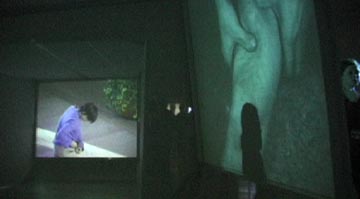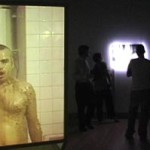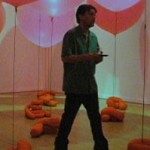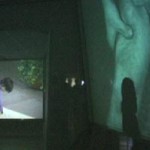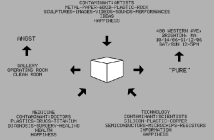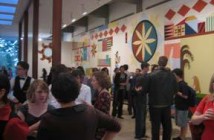You are being watched. We all are. As I write this in the solitary confinement of my apartment, I am reminded, by the sight of the ominous black ball attached to the building adjacent to mine, that I am not always as alone as I think. But who is watching us and when? The camera is turned at us at all times, but where does the watching occur? When does the video feed become activated by the comprehension of human eyes? It is only through the appearance of video surveillance’s constant eye that leads society into the belief that a panopticon exists and to act accordingly.
Surveillance’s existence is a byproduct of the society we live in, which is largely comprised of the gathering and exchange of information. Information is power and power determines where we stand on the food chain. For the most part, artists have always been on the bottom of that chain. Since the 1940s with the attraction of the communist party for young idealist artists and entertainers, we as artists have been blacklisted from countries and denied freedoms by those in the seat of power. While the times have changed, and artists are generally not looked upon as being the next revolutionaries or feared for speaking their minds, surveillance has not left the realm of the artist’s intellect. Balance and Power: Performance and Surveillance in Video Art at Brandies University’s Rose Art Museum delves into the notions of how surveillance, interaction with video, power, and art interact in the age we live in today.
There are many ways to interpret this exhibition. I went to the opening reception, not just for the sake of free cheese and wine, but also for the pure selfish indulgence of doing some surveillance of my own--namely people watching. I found it oddly appropriate to take my good friend, the video camera along for this excursion. For what better occasion could there be to hide behind a camera than at a show about surveillance?
In Balance and Power, all aspects of how we perceive the realm of video and video surveillance are represented. In Jenny Marketou’s99 Red Balloons: Be Careful Who Sees You When You Dream, the viewer, as I discovered through my own surveillance of overhearing the explanation of the artist, is seduced by the comfortable space of red illumination, tube like pillows, and balloons, only to be invaded by the unknown threat of hidden, miniature video cameras. I found the crowded, wine-buzz atmosphere of the reception complemented this piece well. I watched people make themselves comfortable in the relaxing atmosphere of the installation through the flickering faces of the TV monitors posted at the entrance of the space. Marketou encapsulates perfectly what it feels like to live in a society where comfort can be watched and criticized, leaving the viewer/participant emotionally at odds.
From Marketou’s installation, I made my way into the darkened heart of the exhibition in the back gallery of the museum. The back gallery, dimly illuminated by video projections, was cleverly set up with multiple pods skinned by semi-transparent screen material onto which video footage was being projected from various angles. Instead of being just a sterile gallery space, the pod setup transformed the space into a mysterious work of art in its own right. The individual pods become video canvases, as opposed to stagnant monitors, where viewers interacted, sometimes throwing shadows or themselves in front of the projections, making the video a tangible, three-dimensional object. These spaces also created sufficient masks to hide the gaze of onlookers, like myself, taking delight in other gallery attendants lives.
As for the individual video pieces, the content varied greatly from documentation of military use of surveillance to a bathing video by Subodh Gupta entitled Pure, which depicts a man taking a shower. Through the viewing of these intimate secret moments the act of surveillance is fully activated by the viewers eyes. The pieces become alive by entering into existence, by gaining worth through the viewers interaction. The footage is simply not a video signal captured by a mechanical eye anymore, now it is of importance.
In Jim Campbell’s Library, a continuous-motion image comprised of a photogravure portraying the steps leading up to the entrance of the New York Library mounted over a L.E.D. surface, the viewer partakes in a similar quest for information, as do the black blurs of anonymous human figures that traverse the libraries steps. The mysteries of its operations inspired everyone to investigate by peering between its layers at the L.E.D.s transforming what seems to be human blurs on the surface into simple ones and zeros of information telling the L.E.D.s to either be on or off. The anonymity of the blurs seems to suggest the information, as it exists before it is activated. For instance, a man wearing a ski mask walking into the library is just that if no one is watching him, but later after he is being investigated for a kidnapping that occurred later that day, the footage goes from a blur to a clearer focus. The abstraction of the library also plays in quite nicely, illustrating a gathering of information, similar to the dark moving blurs of the viewers making their way to and from this source.
Whether surveillance is used as a social molding agenda to bleed out temptations from its citizens to commit unjust behaviors, protect society from evil foreign predators, execute military missions, or to satisfy voyeuristic fantasies, Balance and Power embodies all aspects of the video medium. It is important to realize that the overall experience of the exhibition is a piece in itself, activated by the viewer, which in my case was glorified through the presence of the swarms of individuals attending the opening reception and captured by my own video camera. While I was granted special permission to bring my video camera to the show, you will have to leave yours at home, using only your memory for surveillance over the premises.
Links:
Rose Art Museum
"Balance and Power: Performance and Surveillance in Video Art" is on view iuntil December 17th at the Rose Art Museum on the campus of Brandeis University in Waltham, MA.
All images are courtesy of the author and the Rose Art Museum.

